GIGABYTE GB-BXi7H-5500 Broadwell BRIX Review
by Ganesh T S on January 29, 2015 7:00 AM ESTPerformance Metrics - II
In this section, we mainly look at benchmark modes in programs used on a day-to-day basis, i.e, application performance and not synthetic workloads.
x264 Benchmark
First off, we have some video encoding benchmarks courtesy of x264 HD Benchmark v5.0. This is simply a test of CPU performance. Similar to our observations in the previous section, the higher clock rate of the i7-5500U helps the Broadwell unit gain a slight edge over its Haswell counterpart.
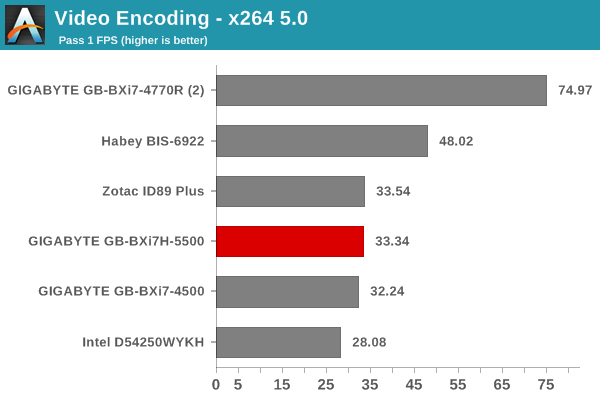
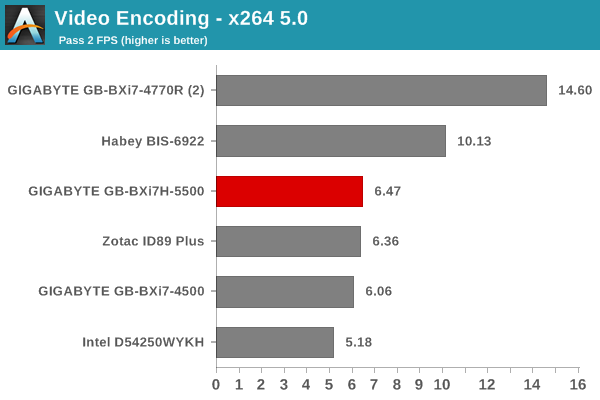
7-Zip
7-Zip is a very effective and efficient compression program, often beating out OpenCL accelerated commercial programs in benchmarks even while using just the CPU power. 7-Zip has a benchmarking program that provides tons of details regarding the underlying CPU's efficiency. In this subsection, we are interested in the compression and decompression MIPS ratings when utilizing all the available threads.
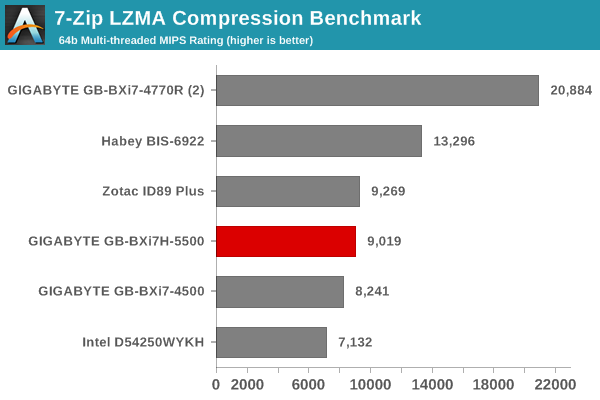
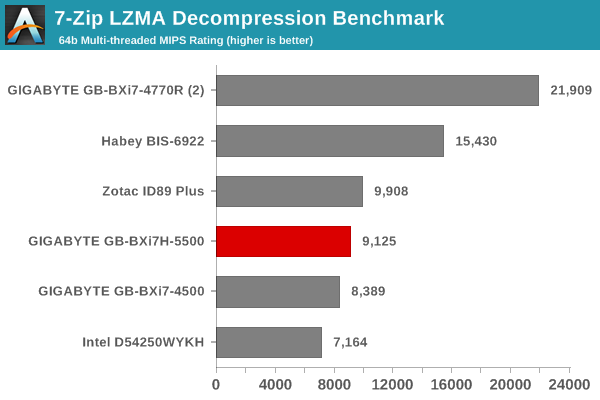
TrueCrypt
As businesses (and even home consumers) become more security conscious, the importance of encryption can't be overstated. CPUs supporting the AES-NI instruction for accelerating the encryption and decryption processes have, till now, been the higher end SKUs. However, with Bay Trail, even the lowly Atom series has gained support for AES-NI. The Core i7-5500U in the BXi7H-5500 does have AES-NI support. TrueCrypt, a popular open-source disk encryption program can take advantage of the AES-NI capabilities. The TrueCrypt internal benchmark provides some interesting cryptography-related numbers to ponder. In the graph below, we can get an idea of how fast a TrueCrypt volume would behave in the GIGABYTE GB-BXi7H-5500 and how it would compare with other select PCs. This is a purely CPU feature / clock speed based test.
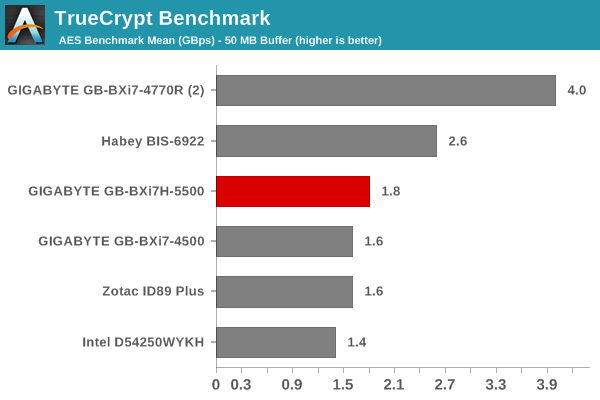
Agisoft Photoscan
Agisoft PhotoScan is a commercial program that converts 2D images into 3D point maps, meshes and textures. The program designers sent us a command line version in order to evaluate the efficiency of various systems that go under our review scanner. The command line version has two benchmark modes, one using the CPU and the other using both the CPU and GPU (via OpenCL). The benchmark takes around 50 photographs and does four stages of computation:
- Stage 1: Align Photographs
- Stage 2: Build Point Cloud (capable of OpenCL acceleration)
- Stage 3: Build Mesh
- Stage 4: Build Textures
We record the time taken for each stage. Since various elements of the software are single threaded, others multithreaded, and some use GPUs, it is interesting to record the effects of CPU generations, speeds, number of cores, DRAM parameters and the GPU using this software.

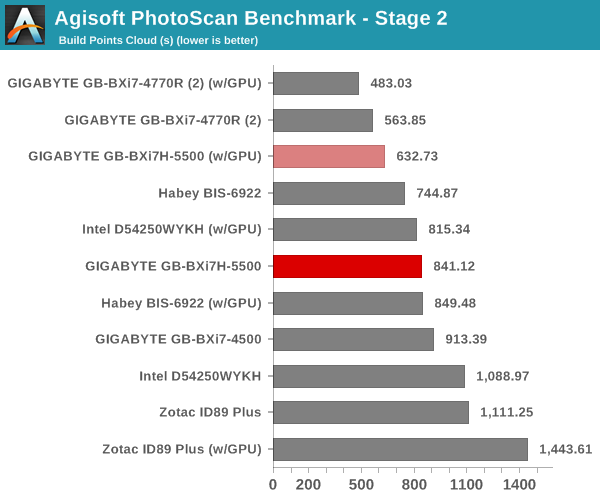
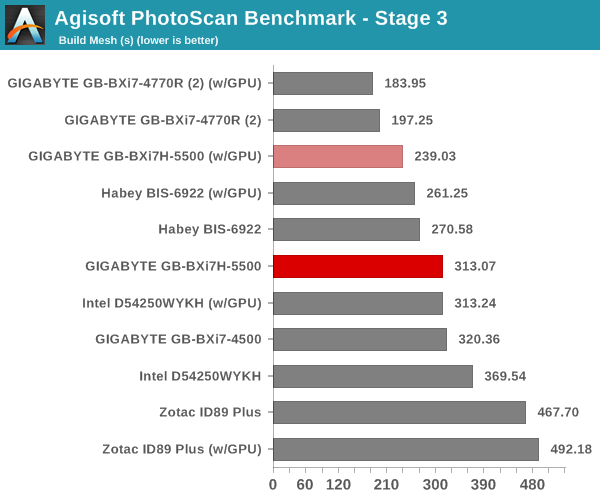
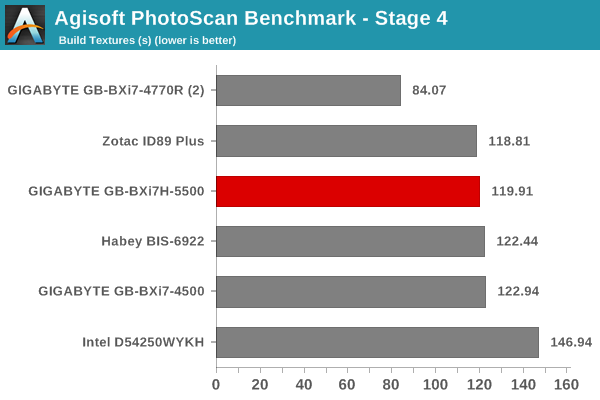
Dolphin Emulator
Wrapping up our application benchmark numbers is the Dolphin Emulator benchmark mode results. This is again a test of the CPU capabilities, and only the power-hungry Iris Pro-equipped BRIX Pro (Core i7-4770R) fares better than the BXi7H-5500 amongst all the compared PCs.











53 Comments
View All Comments
jaydee - Thursday, January 29, 2015 - link
I was hoping for a bit more here from Intel. Looking at the encoding, compressing, encrypting benchmarks, almost nothing was gained performance-wise, or in terms of power consumption.Flunk - Thursday, January 29, 2015 - link
Broadwell is an incremental update so it's not a big surprise.gonchuki - Thursday, January 29, 2015 - link
Doesn't even look incremental, more like a step revision of Haswell (just a node shrink and nothing else). It's the same processor Intel launched in 2013, but on a 14nm node.Refuge - Thursday, January 29, 2015 - link
Tick Tock Tick Tock.Although I've noticed their "Tick Tock" Has been slightly off cadence since their "Mobile First" strategy.
quophog - Friday, January 30, 2015 - link
No surprise really. No competition at all at the performance end. All their effort is going in to the ultra low power & cost end where ARM based architectures currently dominate. Very sad for everyone (except intel share holders) that AMD couldn't keep up with Intel R&D and fab spending.It's a long way off anyway, but I really hope Intel fab advantage doesn't let them eventually monopolise mobile procs too..
Haravikk - Friday, January 30, 2015 - link
Is that really such a bad thing? Making a smaller, much more power efficient processor without sacrificing any performance is still a pretty big accomplishment. While it might not make existing machines much more exiting, the really interesting part is what new things it makes possible.It's for this reason I hate this new Brix machine; it's the same horrific chassis as before, the with the same anaemic cooling. It should be possible for this to be entirely passively cooled, particularly if they want for a smaller, flatter, aluminium design.
eanazag - Friday, January 30, 2015 - link
Intel has done well, but with a competitive AMD we get better prices and more features. ARM has kept Intel moving, but look at the server market. Prices run from $200+ - north of $2000 for 2P systems. And Intel has the middle filled out too. Intel is charging whatever the hell they want there.eanazag - Friday, January 30, 2015 - link
It does look incremental in some benches. In others it is on par. For this type of system I would be leaning towards the 4770R. I don't care for the gaming performance on the 5500U. It is fine at 1280x1024/1366x768. I'd rather have the option to take a step up. The 4770R can do decent in 1600x900/1600x1000. For $750+ I'd like to be doing better. Broadwell Iris Pro may be what I'm hoping for.Otherwise, I'm a 5500U with a mobile GPU built-in - pricing and features may see which way I lean. I'm not a HTPC user.
nathanddrews - Thursday, January 29, 2015 - link
I don't think we should jump to judgment based upon multiple platforms with vastly different components. The closest competitor in this review is the 4500U, which the 5500U decimates in half the benchmarks, while leading it by at least a small margin in the rest. I'm looking forward to a more controlled, thorough review of Broadwell.I know that the gaming tests are set in stone and you try not to change them, but can we please drop the 1280x1024 test and replace it with 1280x720? It's 30% less taxing for these weak GPUs and is much more likely to be used by gamers - either on HDTVs, notebook displays (768p), and widescreen monitors. Nearly all 360/PS3 games are 720p, so many people are comfortable with that resolution and it scales to 1080p, 1440p, and 4K. It's just more realistic. No one games at 1280x1024 anymore unless they like pillarboxing and letterboxing at the same time. 720p and 1080p are really the only meaningful resolutions for these GPUs. You can save yourself some time, too...
ATC9001 - Thursday, January 29, 2015 - link
+1 for 720p resolution. If possible atleast add this to existing HTPC benchmarking, and of course when the benchmark is revamped for it's next iteraion, drop 1280x1024 completely!